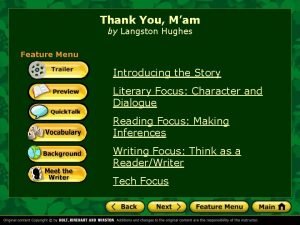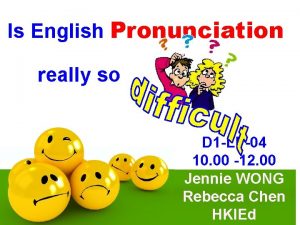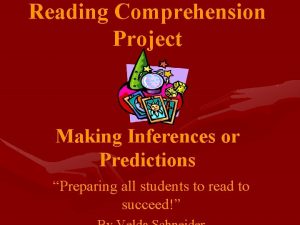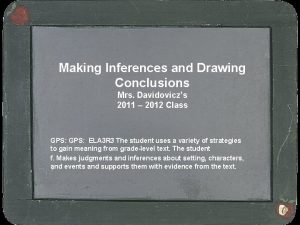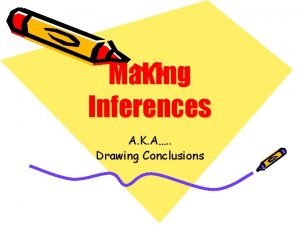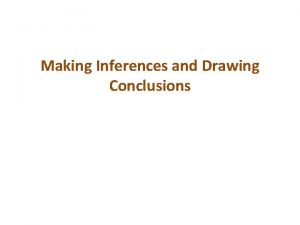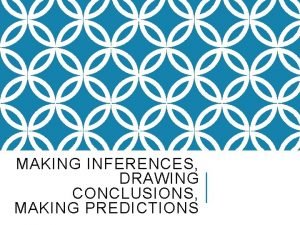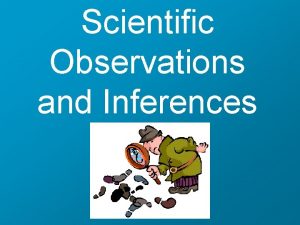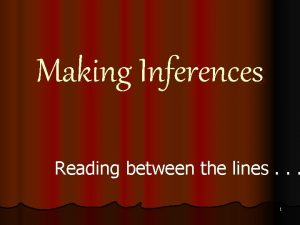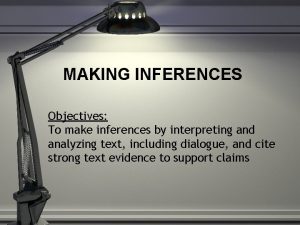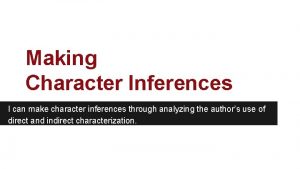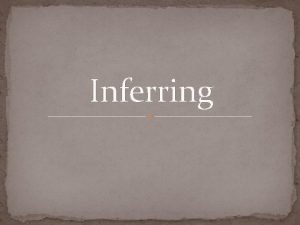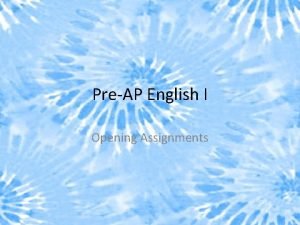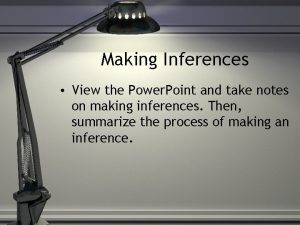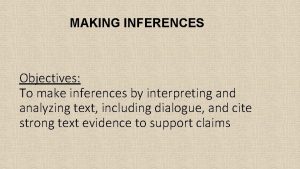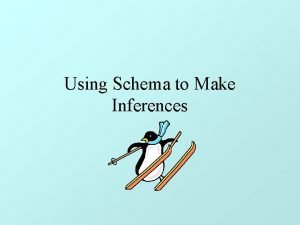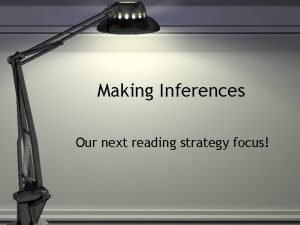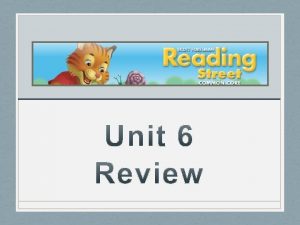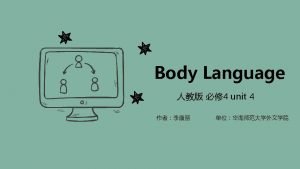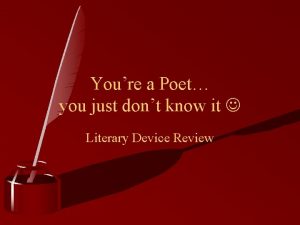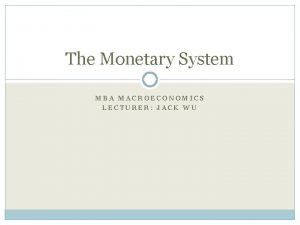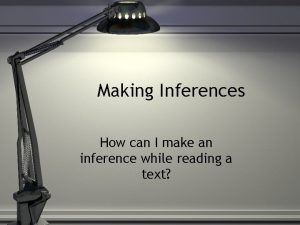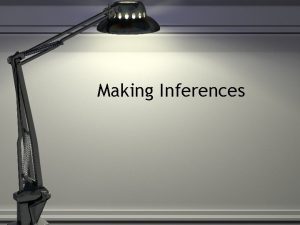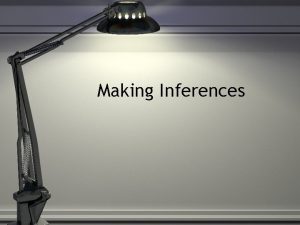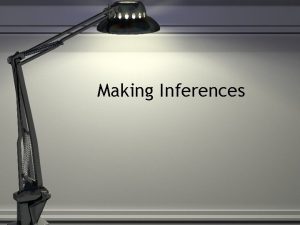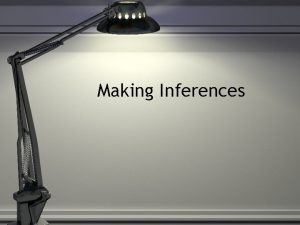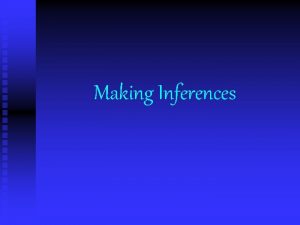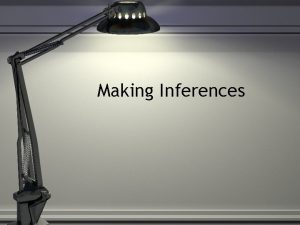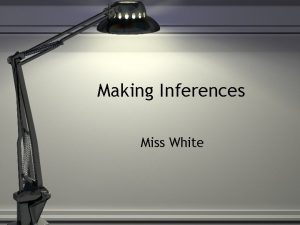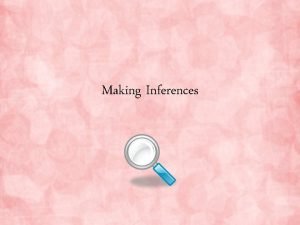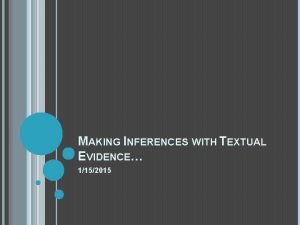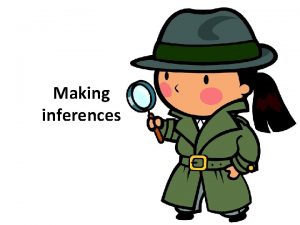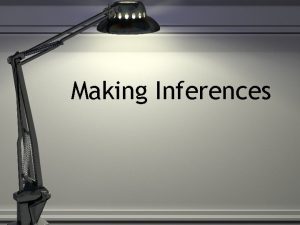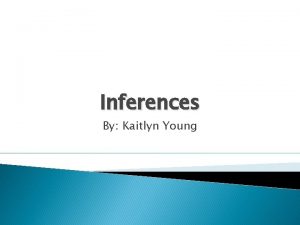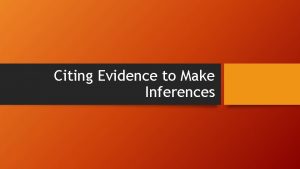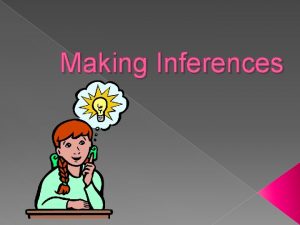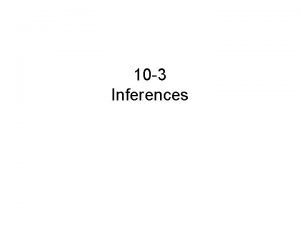Making Inferences Inference Take what you know and























- Slides: 23

Making Inferences

Inference • Take what you know and make a guess! • Draw personal meaning from text (words) or pictures. • You use clues to come to your own conclusion.

Make an Inference! • What does this image tell me?

Question… • What did I already know that helped me make that inference? • Did I use a picture or written clues?

Help Me Make an Inference!

More Questions… • Did you use words, graphs, or picture clues to help you make a guess about what that cartoon meant?

Try Again! • Can he draw more than tigers? • Look up words you don’t know!

Make 1 more Inference

How Do Good Readers Make Inferences? • 1. 2. 3. 4. 5. 6. 7. They use: Word/text clues Picture clues Define unknown words Look for emotion (feelings) Use what they already know Look for explanations for events ASK themselves questions!

Make Another Inference • Miss White has recess duty. Jacob finds a frog, picks it up, and runs over to show it to Miss White screams, jumps, and runs as fast as she can into the school. • What can you infer from this passage? • What are the “clues” in this passage?

Authors vs. Readers • Authors Imply, Readers Infer. • Authors make implications that readers have to infer. • What do I mean by these statements? • Good Readers are Detectives who are always looking out for clues to help them better understand stories and pictures.

Drawing Conclusions

Drawing Conclusions • Authors don’t always tell you everything. They may give you a few details about what happens in the story or about the characters. • You can use the details and what you know to draw conclusions. • A conclusion is a decision you reach that makes sense after you think about the details or facts that you have read. Wash Publishing Co. 2009

Drawing Conclusions • A conclusion is a decision or judgment based on information. Good readers try to draw conclusions as they read based on the information the writer gives and on what they know from their own experiences. • We use our observations as well as what we already know to draw conclusions. • Authors don’t usually tell readers what to think about a story’s facts and details. • Let’s look at a situation…

Drawing Conclusions • Situation: Brad said, “The smell of popcorn filled the air. I heard the audience laughing. “ What conclusion can you draw?

Did you conclude that Brad was at the movies?

Drawing Conclusions • Brad added, “People were buying peanuts and cotton candy. They cheered for the man with the ball. Does this new information change things? What is your conclusion?

Did you conclude that Brad was at a baseball game?

Drawing Conclusions • Brad added, “I even heard loud roars that sounded like lions. The elephants marched around the ring. ” What is your conclusion now?

You can conclude that Brad is at the circus!

Drawing Conclusions • When we draw a conclusion, it is based on evidence and our knowledge about things. • Sometimes, one piece of information isn’t enough to make a correct conclusion. • Brad could have been at the movies. But then we learned more. He could have been at a baseball game. With our new evidence, we can draw the conclusion that he is at the circus.

You draw conclusions every day about incidents you witness, information you gather or about texts you read. If you see smoke filtering out of the kitchen and the smoke alarm is buzzing, what conclusion would you draw? There is a fire in the kitchen!

Read the following paragraph carefully so you will be able to draw conclusions: A crash of thunder had awakened Allison. She couldn’t go back to sleep, so she decided to go to the kitchen to make some cranberry muffins. Wouldn’t her family be surprised with such a breakfast treat! Allison felt her way along the darkened hallway. When she got to the kitchen, she flicked on the light switch. Nothing happened! Why didn’t the lights go on? The storm must have caused a power failure. How did you reach this conclusion? Allison was awakened by thunder. What time of day was it? Early morning How did you know? Allison was asleep; hall was dark; wanted to surprise family with breakfast
 What is inferring
What is inferring Making inferences with dialogue thank you ma'am
Making inferences with dialogue thank you ma'am I take it you already know of tough and bough
I take it you already know of tough and bough Prediction vs inference venn diagram
Prediction vs inference venn diagram Drawing conclusions and making inferences powerpoint
Drawing conclusions and making inferences powerpoint Drawing inferences examples
Drawing inferences examples Drawing conclusions meaning
Drawing conclusions meaning Making inferences drawing conclusions
Making inferences drawing conclusions What are observations and inferences
What are observations and inferences Making inferences: reading between the lines answer key
Making inferences: reading between the lines answer key Inference objectives
Inference objectives By making inferences based on analysis of a character
By making inferences based on analysis of a character Making inferences is reading between the lines.
Making inferences is reading between the lines. Making inferences examples
Making inferences examples Making inferences powerpoint
Making inferences powerpoint Inference objectives
Inference objectives Making inferences essential questions
Making inferences essential questions Making inferences reading strategy
Making inferences reading strategy Brainpop making inferences
Brainpop making inferences If you're happy and you know it stomp your feet
If you're happy and you know it stomp your feet You're a poet and you don't know it
You're a poet and you don't know it If you're blue and you don't know
If you're blue and you don't know You take $100 you had kept
You take $100 you had kept Good inferences
Good inferences

